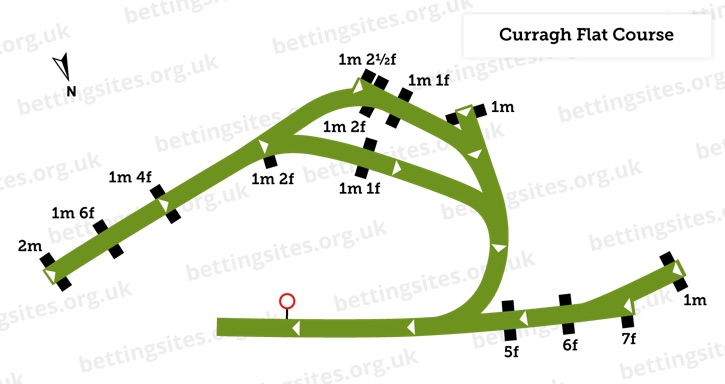India's first & foremost horse racing portal
DUBAI DUTY FREE IRISH DERBY, Gr.1
By Major Srinivas Nargolkar (Retd.) | 24 Jun 2021 |

It was inevitable that after the Epsom Derby had become an established race, Ireland should have gone into the emulation mode to establish its own counterpart. Indeed, two attempts were made in the first half of the nineteenth century but they petered out after a few renewals. Ireland was third time lucky in 1866 and the race has continued to the present day without a break, even during the war years. Initially, it was run over a longer distance but since 1872 it has been contested over a mile and a half. With Irish Hospitals Sweepstake joining the race in 1962, the prize money got a tremendous boost and the race became one of the richest in Europe. From Orby in 1907 to Harzand in 2016, eighteen horses have bagged the Epsom-Curragh Derby double.
Track
Curragh is about forty kilometres to the south west of Dublin. Like Epsom, the track at Curragh is horse-shoe shaped but while they run anti-clockwise in England, the Irish track is right handed. As at Epsom, Curragh has three chutes from the main track. For the Derby, the runners have to wend their way to the start across the Sheep Graze infield. The first four furlongs or so are uphill and then there is a very gentle, downward slope. The second right-handed turn brings the field into the straight which is a shade under three furlongs with the last furlong a testing climb. There was a time when one could take a train from Dublin and alight close to the Grandstand. The entire complex -- tracks, grandstands, training facilities and amenities -- underwent a major redevelopment at a cost 80 million euros just recently. There are rain clouds around Curragh from today and the going needs a definite check on Saturday.

Trends
All trends pale before the utter domination of Ballydoyle runners this century. Nineteen of the winners have been trained in Ireland and of them thirteen, trained by Aidan O'Brien, hail from Ballydoyle. No trainer anywhere has had a vice-like grip on such a big race. Of the ten winning favourites, seven have come from Ballydoyle. It is often said that sheer numbers spawn his effective 'saturation bombing' strategy. That is not so and does little to acknowledge his skill and craft. In the last twenty years, he has fielded eighty one runners and that gives him a strike rate of 16 %. Contrast that with the record of foreign trained runners over the same period. Forty four runners, not trained in Ireland, have come to Curragh for the Derby and only Hurricane Run and Jack Hobbs have scored; an average of 4.5 %.
Six times O'Brien has saddled the first three horses past the post in the Irish Derby and once even had all the four in the frame. Four of the five Epsom-Curragh doubles were bagged by Ballydoyle runners. That is not a result of just numbers. To understand -- not necessarily solve -- the Curragh riddle, one has to be able to analyse his hand. Of his eight Epsom Derby winners, seven ran at Curragh; four won, two placed and only one was unplaced. In the seven years that he did not win the Irish Derby, O'Brien was the trainer of the runner-up or the third. It is obvious that the best Ballydoyle runner of the day has always given a return. To single out that runner is not easy because he has about four of them running every year and while he has sent out red hot favourites like Galileo, High Chaparral and Australia, he has also led in rank outsiders like Frozen Fire and Sovereign. As any bridge player will tell you, assessing a hand is the simpler part. How you play it is more important.
For the record, though, the average size of the field is ten runners. Favourites have obliged in exactly half the races. Seamie Heffernan is the leading jockey with four wins. (Ryan Moore, surprisingly, is still looking for his first despite having been aboard a few favourites). Galileo has sired five winners and his son Teofilo one. Montjeu comes next with four while two of sons -- Camelot and Authorized -- have one each.
The Race This Year
Fourteen of the past twenty winners of the Irish Derby had previously raced in the Epsom Derby three weeks earlier. This year's winner, Adayar, is not in the Curragh field but the other three in the frame at Epsom are and they can kickstart the discussion. They were, of course, well beaten and strung out in what was a 'trappy' race. Mojo Star (Sea The Stars - Galley by Zamindar) (DI 2.20) is still a maiden after three runs though he has never been worse than second in all of them. Sea The Stars has already produced Harzand to win this race but Mojo Star's dam, from an excellent family, has a DI of 3.24. The Hannons have usually excelled with horses around a mile and a Derby was generally not their cup of tea. However, Mojo Star is trained by a new generation Hannon, has been supplemented into the race and has had good support throughout the week. He will be ridden by the twenty year-old young Irish jockey Rossa Ryan. Hurricane Lane (Frankel - Gale Force by Shirocco) (DI 0.52) carried Godolpin's first colours at Epsom. The Dante winner never looked like winning and now has to carry the Frankel flag planted by Adayar. The last filly to win this race was Balanchine in 1994 and she was owned by Godolphin. Charlie Appleby's stable is in terrific form, William Buick continues his association with the colt and Hurricane Lane could be in the mix. The Tattersalls Irish 2000 Guineas, Gr.1 winner Mac Swiney (New Approach - Halla Na Saoire by Teofilo) was a distant fourth behind Adayar. He is at his best when the ground is heavy and the going will be crucial to his chances. As expected, trainer Jim Bolger will give his son-in-law Kevin Manning the leg-up.
The Ballydoyle fillies have been in sparkling form this year with four of them winning a Classic in three countries. The colts, though, have been a bit underwhelming with only St. Mark's Basilica winning the Qatar Prix du Jockey Club, Gr.1. St. Mark's Basilica doesn't run at The Curragh nor does Bolshoi Ballet, Aidan O'Brien's sole runner and the favourite at Epsom. As usual, the Ballydoyle Battalion is strong in numbers, relying on potential to make up for lack of performance. One of the runners that O'Brien scratched at the last minute at Epsom was High Definition (Galileo - Palace by Fastnet Rock) (DI - 0.71) who heads the market here. Last week he could be backed at 6/4, came down to odds on for a while but support for Mojo Star has seen him ease significantly. Even when he was taken out at Epsom, his odds were much shorter than the three who finished behind Adayar, including his Dante conqueror Hurricane Lane. The Dante has not thrown up a winner since so that form line is suspect. Admittedly, High Definition went into the Dante under a cloud but being taken out of the Derby suggests that he was still not back to his best. He has had three more weeks to come into his own but the odds are too short for a colt who has raced just once this year and not won. Ryan Moore has elected to ride High Definition. Has he chosen correctly this year ?
Last year, O'Brien won this race with Santiago who had skipped the Derby at Epsom and won the Queen's Vase, Gr.2 at Royal Ascot. This year, Ballydoyle sent a posse of five three year-olds to Royal Ascot, none of them won while two were runners-up. One of them was Wordsworth, comfortably beaten by Godolphin's Kemari in the Queen's Vase, Gr.2. Wordsworth will have the most successful Irish Derby jockey this millennium -- Seamie Heffernan -- holding the reins. Lone Eagle has won four races and none of his rivals can match that number. He is a son of Galileo and the third overseas trained challenger after Mojo Star and Hurricane Lane. Having Dettori astride is a major plus point. Earlswood is trained by J.P. Murtagh who has ridden three winners of this race and is looking for his first as trainer. Earlswood won the Heider Family Stables Gallinule Stakes, Gr.3 at Curragh on his last start. Lone Eagle and Earlswood do have to find a lot more for they have never run in a Gr.1 race before.
The Field In A Nutshell
11 runners with 5 from Ballydoyle. The three highest rated runners are Mac Swiney (118), High Definition (115) and Mojo Star (114). One maiden (Mojo Star). Three last start winners (Earlswood, Lone Eagle and Fernando Vichi). Pedigree enthusiasts may be interested to know that nine have Galileo in their pedigrees. And, there is just one participant who does not have Urban Sea in his. That is Van Gogh, sired by the American Triple Crown winner and having a dual Classic winner as his dam. That is as good a pedigree as it gets. Van Gogh, though, has been hugely disappointing so far.
PAST THE POST
An Epsom Derby winner came to India only at the start of the 21st century. However, three winners of the Irish Derby had reached the Indian shores in the first half of the previous century.
The first to arrive was Bachelor's Wedding, the winner of Irish Derby in 1913. He had been imported by the Chief of Kagal who raced under the name "R.R.S.". Trained by Rustomjee Byramjee, Rashid Byramji's grandfather, Bachelor's Wedding won the Viceroy's Cup twice and the King-Emperor's Cup once. He was retired to Kagal Stud as a stallion and he did produce a couple of good horses. However, in those days there was hardly any incentive for Indian-breds because the racing programme didn't cater for them. A pity, really, because Bachelor's Wedding's elder full-brother, Bachelor's Double was not only an Irish Derby winner but was also a most successful sire who became a chef de race in the 'stout' category.
The 1917 Irish Derby winner First Flier emulated Bachelor's Wedding by winning the Viceroy's Cup in 1919. First Flier was originally owned in India by Mr. J.C. Galstaun who sold him to his friend Mr. T.M. Thaddeus because he then had Dark Legend and St. Quin in his string. St. Quin broke down, Dark Legend was under a cloud and First Flier grabbed the opportunity to win the big prize. First Flier later fell down in the Burdwan Cup over hurdles and was euthanised.
The 1936 Irish Derby was won by Mondragon beating Crushed Corn with the Irish 2000 Guineas winner Cornfield unplaced. The Maharaja of Baroda bought the winner and the runner-up for just under a lakh of rupees. Mondragon did not race in India and Crushed Corn, who did, failed to win. Both were retired to the Baroda Stud as stallions. Neither was particularly successful though Mondragon's daughter Kaniya Kumari did win the Indian 1000 Guineas, Gr.1. Mondragon holds one distinction. His son Flower of Gwalior (out of the inaugural Indian Derby winner Princess Beautiful) was the first Indian-bred to win a race in England, though it was over hurdles. Cornfield, the other horse mentioned as having run in Mondragon's Irish Derby, also came to India and stood as a stallion in Maharaja of Kashmir's stud at Jammu.
The three Irish Derby winners who carried the colours of Indian owners are Sayajirao (Maharaja of Baroda), Sodium (Mr. Radha Sigtia) and Steel Pulse (Mr. Ravi Tikkoo). Pandu Khade, who had a ride earlier ridden in the Epsom Derby, was astride Sicilian Prince in the 1962 Irish Sweeps Derby.
.png)
 Register Now
Register Now 

